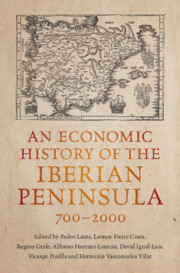Book contents
- An Economic History of the Iberian Peninsula, 700–2000
- An Economic History of the Iberian Peninsula, 700–2000
- Copyright page
- Contents
- Figures
- Tables
- Contributors
- Preface: By Way of Presentation
- Introduction
- Part I The Making of Iberia, 700–1500
- Part II Globalization and Enlightenment, 1500–1800
- Part III Industrialization and Catching Up, 1800–2000
- 18 Economic Growth and the Spatial Distribution of Income, 1800–2000
- 19 Population Growth, Composition and Educational Levels
- 20 Economic Policies and Institutions
- 21 Iberian Financial System, 1800–2000
- 22 Economic Growth and Structural Change in the Iberian Economies, 1800–2000
- 23 Living Standards in Iberia, 1800–2010
- 24 Iberian Globalization and Catching Up in the Poor South European Periphery, 1830–2010
- 25 The Iberian Economy in Comparative Perspective, 1800–2000
- References
- Index
22 - Economic Growth and Structural Change in the Iberian Economies, 1800–2000
from Part III - Industrialization and Catching Up, 1800–2000
Published online by Cambridge University Press: 22 February 2024
- An Economic History of the Iberian Peninsula, 700–2000
- An Economic History of the Iberian Peninsula, 700–2000
- Copyright page
- Contents
- Figures
- Tables
- Contributors
- Preface: By Way of Presentation
- Introduction
- Part I The Making of Iberia, 700–1500
- Part II Globalization and Enlightenment, 1500–1800
- Part III Industrialization and Catching Up, 1800–2000
- 18 Economic Growth and the Spatial Distribution of Income, 1800–2000
- 19 Population Growth, Composition and Educational Levels
- 20 Economic Policies and Institutions
- 21 Iberian Financial System, 1800–2000
- 22 Economic Growth and Structural Change in the Iberian Economies, 1800–2000
- 23 Living Standards in Iberia, 1800–2010
- 24 Iberian Globalization and Catching Up in the Poor South European Periphery, 1830–2010
- 25 The Iberian Economy in Comparative Perspective, 1800–2000
- References
- Index
Summary
This chapter examines the main stages of economic growth and structural change in the Portuguese and Spanish economies and explains the main differences between them and the core European countries. Besides presenting these stages, the chapter also measures the contribution of structural change to economic growth in the long term. Then, the chapter disaggregates further within the three sectors to determine the leading industries at each stage of economic transformation. Finally, the contribution of these sectors to economic growth is studied. Both Iberian countries were latecomers in industrialization and also in agricultural success. With a late start in the mid-nineteenth century in relation to the core European countries, due to both poor factor endowments and institutions, they advanced in terms of structural change during the interwar period and experienced post-1950 growth miracles. Major changes took place when technological change and foreign markets were adapted to their factor endowments. The main differences were the slow path of Portugal in relation to Spain, structural change was less important, with agriculture having a lower (higher) and services a higher (lower) share of GDP and employment during the nineteenth century with the opposite being the case in the twentieth century respectively.
Keywords
- Type
- Chapter
- Information
- An Economic History of the Iberian Peninsula, 700–2000 , pp. 567 - 591Publisher: Cambridge University PressPrint publication year: 2024



